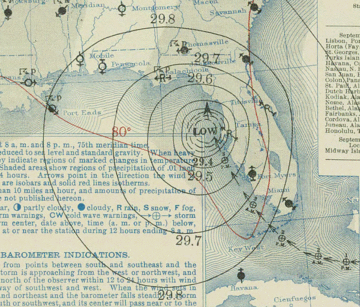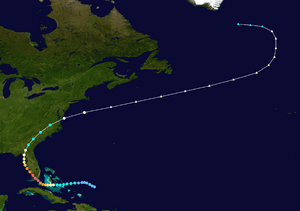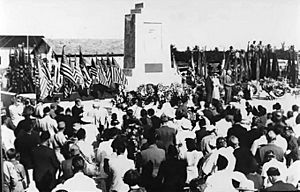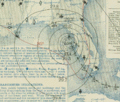1935 Labor Day hurricane facts for kids
| Category 5 major hurricane (SSHWS/NWS) | |

Weather Bureau surface weather map of the hurricane moving up the west coast of Florida
|
|
| Formed | August 29, 1935 |
|---|---|
| Dissipated | September 10, 1935 |
| (Extratropical after September 6, 1935) | |
| Highest winds | 1-minute sustained: 185 mph (295 km/h) |
| Lowest pressure | 892 mbar (hPa); 26.34 inHg (Lowest recorded in the United States, Third-lowest recorded in the Atlantic) |
| Fatalities | 423 |
| Damage | $100 million (1935 USD) |
| Areas affected | The Bahamas, Florida Keys, Southwest and North Florida (Big Bend), Georgia, The Carolinas, Virginia, Maryland, Delaware, New Jersey, New York, New England |
| Part of the 1935 Atlantic hurricane season | |
The Great Labor Day Hurricane of 1935 was an incredibly powerful storm. It was the strongest Atlantic hurricane ever to hit land in terms of how low its air pressure got. It also had some of the strongest winds for a hurricane hitting the Atlantic coast, tied with Hurricane Dorian in 2019.
This hurricane was one of only four Category 5 hurricanes to hit the United States mainland. It caused a lot of damage, especially in the Florida Keys. Many people lost their lives, including veterans who were working on a new highway.
The storm grew very quickly. It passed over Long Key on September 2nd. A huge storm surge (a wall of ocean water) swept over the low islands. This surge changed the land, creating new paths between the bay and the ocean. The strong winds and high waves lasted into the next day, making rescue efforts very hard. The hurricane then moved along Florida's west coast, getting weaker before hitting land again near Cedar Key, Florida.
Contents
How the Hurricane Formed and Moved
The storm started as a disturbed weather area near the Turks and Caicos Islands in late August. By August 31, it became a tropical depression near Long Island in the Bahamas. It quickly grew stronger, becoming a hurricane near Andros Island on September 1.
The storm then got much stronger very fast. It moved towards the Florida Keys at about 10 miles per hour. The center of the storm, called the eye, was about 9 to 10 miles wide. The hurricane hit land late on September 2 near Long Key. At this point, it was at its strongest.
After leaving the Keys, the storm weakened as it moved along the Florida Gulf Coast. It made a second landfall at Cedar Key. The storm then sped up and quickly weakened over the Mid-Atlantic states. It caused a lot of rain, with one area in Maryland getting over 16 inches. The storm finally moved out over the Atlantic Ocean and later combined with another weather system on September 10.
| Most intense Atlantic hurricanes | |||||
|---|---|---|---|---|---|
| Rank | Hurricane | Season | Pressure | ||
| hPa | inHg | ||||
| 1 | Wilma | 2005 | 882 | 26.05 | |
| 2 | Gilbert | 1988 | 888 | 26.23 | |
| 3 | "Labor Day" | 1935 | 892 | 26.34 | |
| 4 | Rita | 2005 | 895 | 26.43 | |
| 5 | Allen | 1980 | 899 | 26.55 | |
| 6 | Camille | 1969 | 900 | 26.58 | |
| 7 | Katrina | 2005 | 902 | 26.64 | |
| 8 | Mitch | 1998 | 905 | 26.73 | |
| Dean | 2007 | ||||
| 10 | Maria | 2017 | 908 | 26.81 | |
| Source: HURDAT | |||||
An interesting fact is that the first time an airplane was flown specifically to find a hurricane was during this storm. On September 2, 1935, Captain Leonard Povey of the Cuban Army flew a Curtis Hawk II to check on the storm. He saw it was stronger than reported but didn't fly into it because he was in an open-cockpit plane. This idea of flying into hurricanes for research didn't happen again until 1943.
Hurricane Records
The Labor Day hurricane holds a record for being the most intense tropical cyclone to hit land in the Western Hemisphere. It had the lowest air pressure ever officially recorded on land. This low pressure showed how incredibly strong the storm was.
The hurricane's winds were about 185 miles per hour when it hit land. This ties it with Hurricane Dorian (2019) for the strongest landfalling Atlantic hurricane in terms of wind speed.
Getting Ready for the Storm
Weather warnings were sent out on September 1 for areas from Fort Pierce to Fort Myers. The U.S. Coast Guard in Miami sent a plane to warn boaters and campers by dropping messages. They made a second flight the next day.
On Labor Day, September 2, warnings predicted the storm would pass through the Florida Straits. People were told to watch out for high tides and strong winds in the Florida Keys. Later that day, hurricane warnings were issued for the Key West area, extending north to Key Largo.
Around 2:00 PM, an official named Fred Ghent asked for a special train. This train was to help evacuate veterans working in camps in the upper Keys. The train left Miami at 4:25 PM. It was delayed by a bridge opening, things on the tracks, and bad visibility. The train finally reached the Islamorada station on Upper Matecumbe Key around 8:20 PM. This was just as the wind suddenly changed direction and the huge storm surge arrived.
What Happened During the Storm
| Strongest landfalling Atlantic hurricanes |
|||||
|---|---|---|---|---|---|
| Rank | Hurricane | Season | Wind speed | ||
| mph | km/h | ||||
| 1 | "Labor Day" | 1935 | 185 | 295 | |
| Dorian | 2019 | ||||
| 3 | Irma | 2017 | 180 | 285 | |
| 4 | Janet | 1955 | 175 | 280 | |
| Camille | 1969 | ||||
| Anita | 1977 | ||||
| David | 1979 | ||||
| Dean | 2007 | ||||
| 9 | "Cuba" | 1924 | 165 | 270 | |
| Andrew | 1992 | ||||
| Maria | 2017 | ||||
| Source: HURDAT, AOML/HRD | |||||
upon striking land. |
|||||
Three ships had trouble during the hurricane. The Danish ship Leise Maersk was carried almost 4 miles inland near Upper Matecumbe Key but everyone on board survived. The American tanker Pueblo lost control and ended up near Molasses Reef. The passenger ship Dixie ran aground on French Reef. Luckily, no one died on these ships.
Near Islamorada, on Upper Matecumbe Key, an eleven-car evacuation train was hit by a powerful storm surge and huge waves. Eleven cars were swept off the tracks. Only the locomotive and its tender stayed upright on the rails. Amazingly, everyone on the train survived this event. The locomotive and tender were later moved back to Miami.
The hurricane caused almost complete destruction in the Upper Keys. The area around what is now Islamorada was hit hardest. The eye of the storm passed a few miles to the southwest. This created a calm period of about 40 to 55 minutes over the Keys.
Nearly every building was destroyed. Some bridges and railway tracks were washed away. The connections that linked the islands, like the railroad and roads, were broken. The main way to travel between the Keys and mainland Florida was the Florida Overseas Railroad.
The Islamorada area was devastated. The hurricane's path of destruction was quite narrow. Its eye was about eight miles wide, and the strongest winds reached about 15 miles from the center. This was smaller than other powerful hurricanes like Hurricane Andrew in 1992. Craig Key, Long Key, and Upper Matecumbe and Lower Matecumbe Keys suffered the most damage. The storm also caused wind and flood damage in the Florida Panhandle, Georgia, and the Tampa Bay Area.
In Georgia, the storm brought over 5 inches of rain. This heavy rain caused cotton crops to spoil. The strong winds also damaged crops and caused minor property damage.
The United States Coast Guard and other groups helped with rescue efforts. Boats and airplanes took injured survivors to Miami. The railroad was never rebuilt. Instead, temporary bridges and ferry landings were built. On March 29, 1938, the last part of the Overseas Highway was finished. This new highway used parts of the old railway's roadbed and surviving bridges.
Remembering the Hurricane
Memorials
Islamorada Memorial
There is a monument in Islamorada, just east of U.S. 1, at mile marker 82. It was designed by the Florida Division of the Federal Art Project and built using local limestone by the Works Progress Administration. It was revealed on November 14, 1937. Many people attended the event. President Roosevelt sent a message expressing his "heartfelt sympathy."
The monument has a frieze (a sculpted band) that shows palm trees bending in strong winds and waves hitting their trunks. In front of the sculpture, a ceramic-tile mural of the Keys covers a stone crypt. This crypt holds the ashes of victims from the makeshift funeral fires, mixed with skeletons found later.
This monument is a gravesite, but it does not list any names. This is because many victims were not identified. The memorial was added to the U.S. National Register of Historic Places in 1995. A plaque near the monument explains that it honors hundreds of American veterans and local citizens who died in the hurricane. It mentions the extreme winds and pressure and how most buildings and the railway were destroyed. The plaque also notes that the cremated remains of about 300 people are in the crypt.
Local people hold ceremonies at the monument every year on Labor Day and Memorial Day. They honor the veterans and civilians who died in the hurricane.
Woodlawn Park Cemetery Memorial
In Miami, at Woodlawn Park Cemetery, there is another monument. It was put there by the Harvey W. Seeds Post No. 29, American Legion. The monument says: Erected by Harvey W. Seeds Post No. 29, The American Legion, in Memory of Our Comrades Who Lost Their Lives on the Florida Keys during the 1935 Hurricane, Lest We Forget.
Like the Islamorada memorial, this one also does not list names. Most of the graves here are unmarked.
Veterans Key
On February 27, 2006, a small island off the southern tip of Lower Matecumbe Key was named Veterans Key. This was done to honor the veterans who died in the hurricane. This island is near where one of the work camps was located. Veterans Key and some concrete pillars are all that remain of the 1935 bridge building project.
Images for kids
See also
 In Spanish: Huracán del Día del Trabajo de 1935 para niños
In Spanish: Huracán del Día del Trabajo de 1935 para niños












